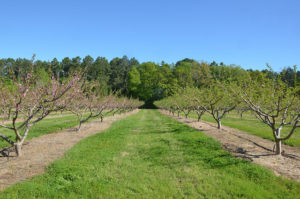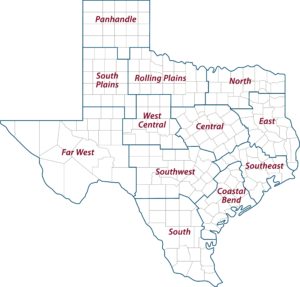Texas Fruit Crop Looks Good Following Freeze
Texas fruit crops appear set for a good year, according to a Texas A&M AgriLife Extension Service expert.

Peach trees at Philley’s Peach Orchard in Overton made it through recent freezes relatively well. Many producers around the state suffered some losses, but a good fruit crop is expected for 2019. (Texas A&M AgriLife Extension Service photo by Adam Russell)
Dr. Larry Stein, AgriLife Extension fruit specialist, Uvalde, said crops like peaches, figs, pears, and strawberries took hits from sub-freezing temperatures two weeks ago, but overall, fruit varieties are showing good fruit sets as the threat of freeze damage wanes.
“I always like to say, ‘I’m cautiously optimistic’ when things look good,” he said. “The overall story is that we will have a fruit crop and likely a good one barring any unforeseen calamities.”
Stein said the freeze did cause losses, especially in low-chill varieties that had bloomed really early. The severity of the damages ranged according to how low temperatures dropped and for how long.
“A lot of low chill varieties just got smoked by the cold,” he said. “There were likely instances where low chill varieties that bloomed early probably lost their entire crop. Young fruit and flowers are the most sensitive to the cold.”
Stein said temperatures reached 22 degrees for eight hours in southern Central Texas, and that temperatures were below freezing for two consecutive nights.
“They probably did OK the first day because it was cloudy and windy, but the next day was colder and still,” he said. “A little wind actually helps because there will be pockets of warmer air. Trees don’t react to wind chill, it’s the temperatures and the exposure time that gets them.”
Stein said it’s likely the freezing temperatures helped producers thin some fruit varieties.
Strawberry growers near Poteet suffered some fruit set losses, but should have ample fruit for their annual strawberry festival, he said. Wine grape growers who waited to prune their vines weathered the cold well.
“With strawberries, there were young fruit on the plants and the freeze got some of them,” he said. “Grapes did well unless they pruned too early which stimulates growth, and early bloom. But most established growers wait, so I don’t expect much damage in that crop.”
Otherwise, growing conditions look good for many areas of the state, especially East Texas and much of Central Texas, due to good moisture profiles, while other parts of the state, like the Wintergarden area have adequate soil moisture but need a decent rain.
“Pecans look good with strong catkin (male flower) numbers, which has me optimistic about fruit sets,” he said. “So, everything is shaping up well. We just need some rain here and there and to monitor for typical disease and pest issues, and 2019 should be a good year all around.”

The 12 Texas A&M AgriLife Extension Districts
AgriLife Extension district reporters compiled the following summaries:
CENTRAL
Fields were prepared for spring planting. Corn planting continued with some fields emerging and looking great. Supplemental feeding of cattle slowed, but dry conditions limited grass growth, and feeding resumed. Pastures were in good condition. Producers sprayed and fertilized fields. Some hay and a little milo were planted. Fertilizer trucks were busy top-dressing small grains and some Coastal Bermuda grass. Grain sorghum was growing well. Topsoil moisture was depleting rapidly with limited rain over several weeks. Grain sorghum planting continued. Wheat continued to look good across the counties. Cattle remained in good condition, and stock tanks were full. Nearly all counties reported fair soil moisture. Overall rangeland, pasture and crop conditions were good in nearly all counties.
ROLLING PLAINS
Weather was mild with some windy conditions and no rain. Winter moisture and warmer temperatures heavily influenced major broadleaf weed emergence. Wheat was in poor to fair condition across the district. Rain was needed to improve wheat condition. Many wheat/cattle producers were grazing fields out. Cattle producers continued to supplement grazing on native rangelands. Cotton producers continued to prepare fields for planting.
COASTAL BEND
Warm and dry conditions prevailed, but rain and a cool front were forecasted. Fields were in good shape with sufficient deep moisture in the soil profile, but planting moisture was starting to get very short. Some producers had to re-work fields, due to the hardened top layer of soil. Corn and grain sorghum were emerging. Cotton was being planted and was coming up where there was sufficient topsoil moisture. Most rice fields were prepared, but producers were waiting on moisture to plant. Improved pastures and hay fields were being fertilized. Some hay was being made from old standing forage as producers cleared pastures to make way for new growth. Some hay fields were being burned to clear off old stands. Rangeland and pasture conditions were good in most areas, and livestock were finding plenty to eat.
EAST
Several days of dry conditions allowed access to some pastures and meadows that were saturated for weeks and months. Pasture and rangeland conditions were fair to good with only Shelby and Trinity counties reporting poor conditions. Subsoil and topsoil conditions were adequate. Counties reported summer grasses were growing. Cherokee County producers were worried about frost and freezing temperatures from the recent cold front. San Augustine County was spraying pastures and meadows with herbicides. Most producers in Shelby and Trinity counties were out of hay. Cattle were testing fences in search of new growth. Smith County livestock were doing fair to good with supplemental feeding taking place. Shelby County reported smaller cattle numbers at the sale barn. The cattle market was down in Houston County. Fly numbers continued to rise in Henderson County. Wild pigs were still causing a lot of damage. Sabine County’s county-wide wild pig abatement program removed several hundred from the population, but reports of damages continued to come in.
SOUTH PLAINS
Temperatures varied with low temperatures in the 30s and highs in the 80s. Subsoil and topsoil conditions were short to adequate. Soil samples revealed decent subsoil moisture down to 24 inches. Pasture, rangeland and winter wheat would benefit with better topsoil moisture. Producers prepared for spring planting. Cattle were in good condition.
PANHANDLE
Most producers received beneficial rainfall that helped area dryland wheat crops tremendously. Warmer temperatures and moisture caused an explosion of growth. Calf weight gains were expected to be excellent on wheat pasture. Center irrigation systems in the area were damaged by storms. Cotton acres appeared to rise, and corn acres held ground as grain sorghum acres continued to fall. Rangelands began to green up, but cattle were still fed supplements. Many producers began to sell stocker cattle.
NORTH
Most counties reported adequate soil moisture levels, and a few counties reported short or surplus conditions. Weather was very pleasant with temperatures reaching 70 degrees, with a cold front at the end of the reporting period. Counties reported receiving between 0.5 of an inch to 1.5 inches of rain. Winter wheat looked much better. Winter pastures were in much better shape as well. Conditions were drying. Most corn was planted, and the first of it was emerging slowly due to low soil temperatures. Bermuda grass pastures were slowly breaking dormancy as well. Stocker operators were happy to see wheat fields come on and perform better. Cattle were leaving hay bales in search of green forage. Weight gains were expected. Most cow/calf producers were nearing the end of calving season. Some producers continued to need supplemental feed. Feral hogs were an issue.
FAR WEST
Temperatures ranged from the low 90s to the low 30s. A cold front blew in late in the reporting period. Reported precipitation was less than an inch, but the light moisture helped settle blowing dust. Grass fires were a major concern with winds. Wheat was really starting to show signs of stress. A lot of blue areas were showing up in fields, and some fields showed stress throughout. Topsoil moisture was rapidly declining with lack of rain and high winds. With wheat fields in the boot stage, rain was needed. Soil temperatures were warming, and grain planting should start soon. Irrigation was in progress. Pre-irrigation for cotton and typical irrigation for pecans were underway. Alfalfa weevil, an uncommon pest in the district, was reported and being monitored closely. Trees were budding. Producers were being told to hold fertilization until after Easter. Rangelands were fairly green, and wildflowers were blooming. Mesquite began blooming in most of the district. Livestock were in good condition, and rangelands continued to provide adequate forage. Producers worked kids and lambs.
WEST CENTRAL
Conditions were relatively warm and dry but turned cold late in the reporting period. Some light frost/freeze damage was noted. Warm windy days continued to dry topsoil throughout the district. Most counties could use rain to help topsoil moisture levels. Winter wheat was in good condition. Rangeland and pastures improved with rapid spring greenup of warm-season grasses. Livestock were doing well. The cattle market opened strong on all classes of calves and yearlings. Feeder prices were up a few dollars per hundredweight, and slaughter cows/bulls were down slightly. Replacement cattle remained steady.
SOUTHEAST
Livestock were in good condition. Planting continued, but fields could use rain to soften up the topsoil. Drier conditions allowed producers to work fields in most areas, but Jefferson County producers reported fields continued to be too wet. Farmers were in those fields doing what they could to get rice planted. Pastures were starting to green up, and conditions remained good. Most producers had fertilizer out and were waiting on rain. Rangeland and pasture ratings were fair to poor with good being most common. Soil moisture levels ranged from adequate to surplus with adequate being most common.
SOUTHWEST
Temperatures ranged from a low of 30 degrees to a high of 80 degrees. Windy conditions did not help soil moisture levels. Corn and milo emerged. Some cotton dry planting occurred, while some farmers were waiting for rain to plant. Pasture and rangeland conditions were fair but would benefit from rain. Livestock were in fair condition with supplemental feeding evident in some counties.
SOUTH
The district reported mild weather conditions with very short to adequate soil moisture levels and rain in a few areas. Live Oak County reported 0.5 of an inch to 1.25 inches. Zapata County reported trace amounts to 1 inch. Jim Wells County reported light rains. Willacy County reported 2 inches of rain. Planting was ongoing. Corn planting should be wrapped up soon. Wheat fields were in the heading stage and in good condition. All crops were under irrigation. Pasture and rangeland conditions were fair to poor and needed rainfall in dry areas. Pasture and rangeland conditions should improve where rain was received. Kleberg and Kennedy counties reported pastures and rangelands were in critical condition due to drought. Supplemental feeding of livestock continued in some areas. Beef cattle were in good condition. Coastal Bermuda grass fields were greening and should be ready to make bales in a few weeks. Producers in Zavala County resumed spinach harvest due to demand. Approximately 80 percent of the cabbage harvest was complete. Corn and sorghum under irrigation made good progress.
Source: Texas AgriLife Extension
